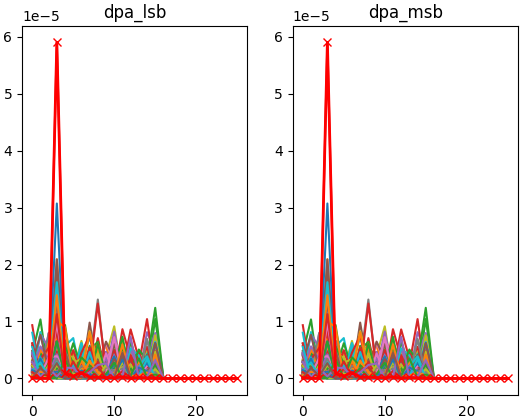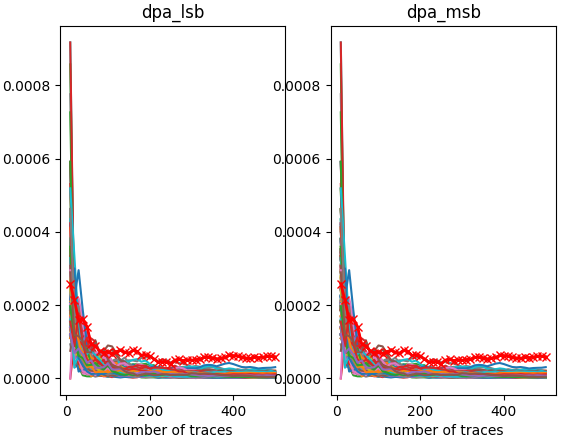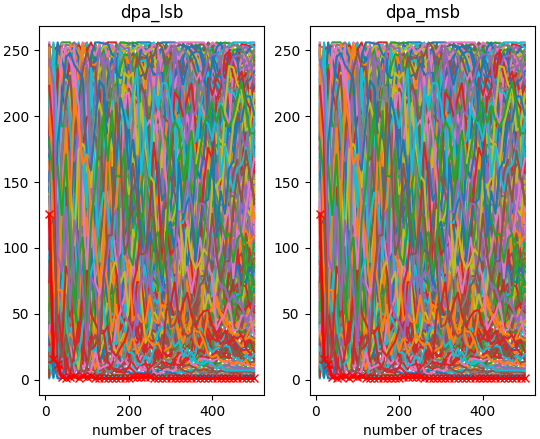Session outputs¶
In side-channel analysis, output management is a crucial final step.
During processing, a large amount of data is manipulated and many statistics are computed. It must be decided which information can be extracted and what measures should be presented:
- extract only the most substantial info (i.e. the secret key)?
- extract the info for all guesses?
- monitor the progression of the attack?
- visualize the results?
- write the results into a file?
- what kind of visualization?
- what kind of file format?
In Lascar, dealing with results is achieved using
OutputMethod.
An OutputMethod is an object
used by the Session to define how the results
must be processed.
Also, the output_steps parameter of the
Session class can be used to indicate at which
number of traces the engine should compute their results.
Every time an engine has results to deliver (through the
finalize() method), it goes by
the OutputMethod.
Lascar already implements a few output methods that will be presented in this tutorial (and in the lascar/examples folder):
DictOutputMethod: results are all stored inside a python dictionnary, with the possibility to save it using pickle.Hdf5OutputMethod: results are stored inside a hdf5 file, all attacks are groups, and datasets for each output step.MatPlotLibOutputMethod: results are displayed on a matplotlib plot, with parameters to indicate the layout (in case of multiple attacks).ScoreProgressionOutputMethod: results are parsed, and the best scores are extracted, and displayed in function of the number of trace.RankProgressionOutputMethod: results are parsed, and the rank of the best scores are extracted, and displayed in function of the number of trace.
The previous script of the DPA example tutorial, which runs on simulated AES traces, is reused here. This time, two DPA are run in parallel: one on the LSB of the output of the 3rd sbox, the other on the MSB.
from lascar import *
from lascar.tools.aes import sbox
container = BasicAesSimulationContainer(500, noise=0.01)
guess_range = range(256)
def selection_function_lsb(value, guess):
return sbox[value["plaintext"][3] ^ guess] & 1
def selection_function_msb(value, guess):
return (sbox[value["plaintext"][3] ^ guess] >> 7) & 1
dpa_lsb_engine = DpaEngine(
"dpa_lsb", selection_function_lsb, guess_range, solution=container.key[3]
)
dpa_msb_engine = DpaEngine(
"dpa_msb", selection_function_lsb, guess_range, solution=container.key[3]
)
Dictionnary output¶
DictOutputMethod
accepts any number of engine arguments. If a filename is specified, the results
are exported in pickle format.
dict_output_method = DictOutputMethod(dpa_lsb_engine, dpa_msb_engine)
# If a filename is specified, DictOutputMethod will save them using pickle
dict_output_method = DictOutputMethod(
dpa_lsb_engine, dpa_msb_engine, filename="dict_output_method.pickle"
)
session = Session(
container,
engines=[dpa_lsb_engine, dpa_msb_engine],
output_method=dict_output_method,
).run(batch_size=50)
Here dict_outut_method has been updated. It contains the results of the
engines, which can be verified like this:
assert np.all(dict_output_method["dpa_lsb"] == dpa_lsb_engine.finalize())
assert np.all(dict_output_method["dpa_msb"] == dpa_msb_engine.finalize())
Results have also been saved to an output pickle file:
assert np.all(
DictOutputMethod.load("dict_output_method.pickle")["dpa_lsb"]
== dpa_lsb_engine.finalize()
)
Outputing intermediate results¶
To add multiple output steps during the analysis, the output_steps
parameter can be issued as in the following example:
session = Session(
container,
engines=[dpa_lsb_engine, dpa_msb_engine],
output_method=dict_output_method,
output_steps=[10, 20, 50],
).run(batch_size=50)
With this feature, it possible to retrieve intermediate results using indexing, such as:
dict_output_method["dpa_lsb"][10] # Result for dpa_lsb after 10 traces
dict_output_method["dpa_lsb"][20] # Result for dpa_lsb after 20 traces
dict_output_method["dpa_lsb"][50] # Result for dpa_lsb after 50 traces
Exporting to a HDF5 file¶
Hdf5OutputMethod
is very similar to the
DictOutputMethod.
With this class, the results are exported to a file in
HDF5 format. For each
DictOutputMethod, the
output filename is mandatory here.
hdf5_output_method = Hdf5OutputMethod("hdf5_output.h5", dpa_lsb_engine, dpa_msb_engine)
session = Session(
container,
engines=[dpa_lsb_engine, dpa_msb_engine],
output_method=hdf5_output_method,
output_steps=[10, 20, 50],
).run(batch_size=50)
h5ls can be used to inspect the content of the generated HDF5 output file. In particular, we can observe that there is a dataset containing the results for the intermediate steps:
$ h5ls -r hdf5_output.h5
/ Group
/dpa_lsb Group
/dpa_lsb/10 Dataset {256, 26}
/dpa_lsb/20 Dataset {256, 26}
/dpa_lsb/50 Dataset {256, 26}
/dpa_lsb/500 Dataset {256, 26}
/dpa_msb Group
/dpa_msb/10 Dataset {256, 26}
/dpa_msb/20 Dataset {256, 26}
/dpa_msb/50 Dataset {256, 26}
/dpa_msb/500 Dataset {256, 26}
/mean Group
/mean/10 Dataset {26}
/mean/20 Dataset {26}
/mean/50 Dataset {26}
/mean/500 Dataset {26}
/var Group
/var/10 Dataset {26}
/var/20 Dataset {26}
/var/50 Dataset {26}
/var/500 Dataset {26}
Note
Note: To access a HDF5 dataset value, use .value attribute
Hdf5OutputMethod
has a static method to load results from a
HDF5 file.
hdf5_output_method_bis = Hdf5OutputMethod.load("hdf5_output.h5")
assert np.all(hdf5_output_method_bis["dpa_lsb/500"][()] == dpa_lsb_engine.finalize())
The results can also be plotted using matplotlib, using
MatPlotLibOutputMethod.
If a solution has been set to the dpa_engines, the corresponding plot is
highlighted. The filename parameter, which is optional, enables
exporting the figure to an image file.
mpl_output_method = MatPlotLibOutputMethod(
dpa_lsb_engine, dpa_msb_engine, filename="foo.png"
)
session = Session(
container, engines=[dpa_lsb_engine, dpa_msb_engine], output_method=mpl_output_method
).run(batch_size=50)

DPA result plotted with matplotlib
Rank and score¶
ScoreProgressionOutputMethod
and
RankProgressionOutputMethod
can be used to plot the rank and score of a DPA analysis. The following example
shows how to monitor the progression of the scores of our 2 attacks, every 10
traces. You’ll observe in particular that multiple output methods can be given
to a session:
score_progression_output_method = ScoreProgressionOutputMethod(
dpa_lsb_engine, dpa_msb_engine
)
rank_progression_output_method = RankProgressionOutputMethod(
dpa_lsb_engine, dpa_msb_engine
)
session = Session(
container,
engines=[dpa_lsb_engine, dpa_msb_engine],
output_method=[score_progression_output_method, rank_progression_output_method],
output_steps=10,
).run(batch_size=50)
# Scores and steps can be accessed:
score_progression_output_method.get_scores()
score_progression_output_method.get_scores_solution()
score_progression_output_method.get_steps()

Score

Rank